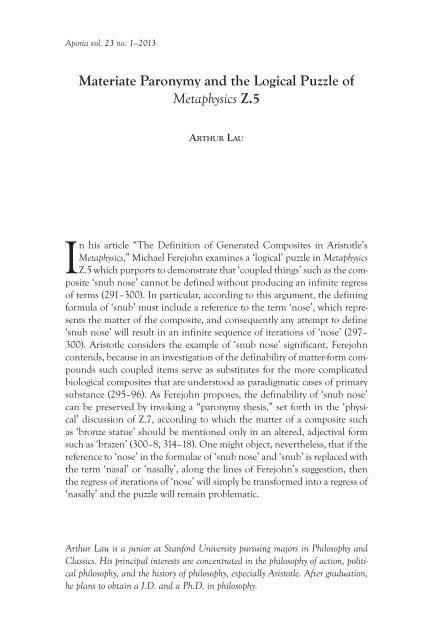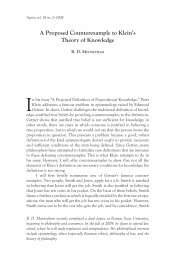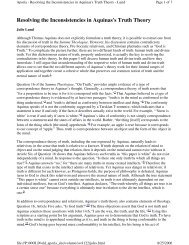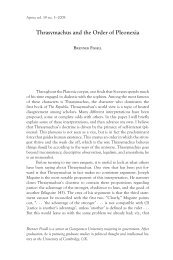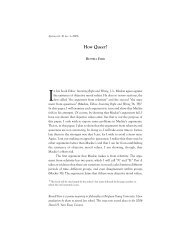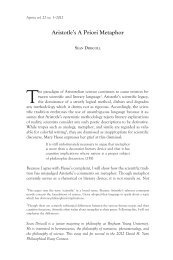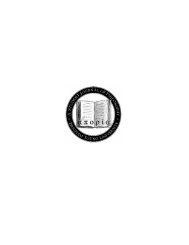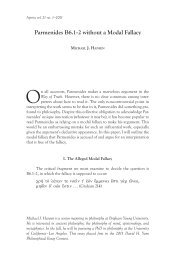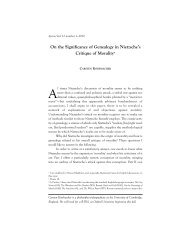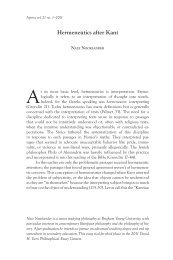Materiate Paronymy and the Logical Puzzle of Metaphysics ... - Aporia
Materiate Paronymy and the Logical Puzzle of Metaphysics ... - Aporia
Materiate Paronymy and the Logical Puzzle of Metaphysics ... - Aporia
- No tags were found...
Create successful ePaper yourself
Turn your PDF publications into a flip-book with our unique Google optimized e-Paper software.
74Arthur LauContinuing this procedure would produce an infinite sequence <strong>of</strong> <strong>the</strong> form‘snub nose’ = ‘snub nose nose nose nose . . .’,suggesting that ‘snub’ has no acceptable definition whatsoever, as (5) <strong>and</strong>(7) conclude (299–300).One might note that a less complicated method <strong>of</strong> deriving <strong>the</strong> infiniteregress than that delineated by Ferejohn would involve taking(4*) ‘snub’ =df ‘concave nose’as given <strong>and</strong> <strong>the</strong>n substituting ‘snub nose’ for ‘concave nose’ as providedin (1′ ) to obtain‘snub’ = ‘snub nose’.From this equivalence it would follow that one could append any number<strong>of</strong> iterations <strong>of</strong> ‘nose’ after any appearance <strong>of</strong> <strong>the</strong> term ‘snub’ simply byexp<strong>and</strong>ing ‘snub’ into ‘snub nose’ <strong>the</strong> desired number <strong>of</strong> times.Ferejohn seeks to resolve this puzzle <strong>and</strong> preserve <strong>the</strong> definability <strong>of</strong>composites such as ‘snub nose’ by appealing to what he calls <strong>the</strong> “paronymy<strong>the</strong>sis” <strong>of</strong> <strong>Metaphysics</strong> Z.7, where Aristotle engages in a ‘physical’ inquirywhich considers material objects from a diachronic perspective as “thingswhich come to be” (301-308).According to <strong>the</strong> paronymy <strong>the</strong>sis, if <strong>the</strong> product <strong>of</strong> a substantialchange is generated out <strong>of</strong> some persisting substratum or matter, <strong>the</strong>n <strong>the</strong>product is described not by <strong>the</strong> name <strong>of</strong> <strong>the</strong> substratum but by a paronymousadjective derived from that name (307–8). Thus, for example, oneshould speak not <strong>of</strong> <strong>the</strong> ‘bronze statue’ but <strong>of</strong> <strong>the</strong> ‘brazen statue’, <strong>and</strong> ingeneral, if ‘that’ (ejkei~no) is <strong>the</strong> persisting substratum, one should call <strong>the</strong>product not ‘that’ but ‘<strong>of</strong>-that’ or ‘thaten’ (ejkeivninon) (307; Z.7 1033a6–8).The matter cannot properly be conceived as ‘that from which’ <strong>the</strong> productcomes to be, because <strong>the</strong> entity from which something genuinely comes tobe is necessarily replaced in substantial change, whereas <strong>the</strong> matter <strong>of</strong> <strong>the</strong>product remains during <strong>the</strong> change (304). With this kind <strong>of</strong> paronymy,which one might call materiate paronymy, <strong>the</strong> matter is not directly named,although its involvement as <strong>the</strong> substratum for <strong>the</strong> generation <strong>of</strong> <strong>the</strong> productis obliquely indicated. As Ferejohn explains, directly naming <strong>the</strong> matterwould “lead into a deeply confused idea <strong>of</strong> <strong>the</strong> very nature <strong>of</strong> a materialsubstratum, namely that it is something that possesses its own individuativenature which is independent <strong>of</strong> what forms happen to be imposed onit” (304).<strong>Materiate</strong> paronymy proves crucial, Ferejohn contends, becauseAristotle claims, in his concluding summation <strong>of</strong> Z.11, that a hylomorphic
<strong>Materiate</strong> <strong>Paronymy</strong> <strong>and</strong> <strong>the</strong> <strong>Logical</strong> <strong>Puzzle</strong> <strong>of</strong> <strong>Metaphysics</strong> Z.5 75compound has no defining formula “with matter” but that it does have aformula “[according] to its primary substance,” one which, in Ferejohn’s interpretation,mentions <strong>the</strong> matter in some way (313–17). Aristotle indicatesin Z.11 that <strong>the</strong> forms <strong>of</strong> biological composites can be instantiated only inparticular kinds <strong>of</strong> matter <strong>and</strong> that <strong>the</strong>se biological substances are essentially‘this in that,’ a certain form in a certain sort <strong>of</strong> matter (314–15). Consequently,Ferejohn asserts that <strong>the</strong> defining formulae <strong>of</strong> both biologicalcomposites <strong>and</strong> coupled things such as ‘snub nose’ must incorporate somereference to <strong>the</strong> matter, even though a formula “with matter,” i.e., one directlynaming <strong>the</strong> matter as a noun, would improperly represent <strong>the</strong> matteras a determinate individual (313–14). Drawing on Aristotle’s statement at1037a29–30 that <strong>the</strong> primary substance is <strong>the</strong> ‘indwelling form,’ Ferejohnargues that to define <strong>the</strong> composite according to <strong>the</strong> primary substanceis to give a formula <strong>of</strong> its form as indwelling or as enmattered (316). Forinstance, if <strong>the</strong> formula <strong>of</strong> <strong>the</strong> human soul, <strong>the</strong> form <strong>of</strong> a human, is ‘XYZ’,<strong>the</strong>n <strong>the</strong> definition <strong>of</strong> human would be ‘XYZ in flesh, blood, etc.’, <strong>and</strong> if<strong>the</strong> formula <strong>of</strong> concavity is ‘PQR’, <strong>the</strong>n <strong>the</strong> definition <strong>of</strong> snubness wouldbe ‘PQR in a nose’ (316). This indirect way <strong>of</strong> referring to <strong>the</strong> matter canalso use a paronymous adjective ra<strong>the</strong>r than a prepositional phrase, showinghow <strong>the</strong> paronymy <strong>the</strong>sis can provide a solution to <strong>the</strong> logical puzzle <strong>of</strong>Z.5, which would o<strong>the</strong>rwise threaten <strong>the</strong> definability <strong>of</strong> not only coupleditems but also biological composites (316–17). In particular, if <strong>the</strong> formula<strong>of</strong> ‘snub’ were to include not <strong>the</strong> noun ‘nose’, but merely <strong>the</strong> adjective ‘innosed’or ‘nosen’, <strong>the</strong>n one could reject (4*) as <strong>the</strong> only possible definition<strong>of</strong> ‘snub’ satisfying <strong>the</strong> condition in (4) that <strong>the</strong> matter must somehow bementioned, <strong>and</strong> <strong>the</strong>reby avoid infinite regress (317–18).While Ferejohn does not elucidate in complete detail <strong>the</strong> mannerin which <strong>the</strong> paronymy <strong>the</strong>sis is supposed to prevent <strong>the</strong> infinite regress,one can provide an approximate reconstruction that will also allow one todiscern an important weakness in his argument. ‘In-nosed concavity’ <strong>and</strong>‘nosen concavity’ seem to be appropriate defining formulae for <strong>the</strong> form<strong>of</strong> snubness but not <strong>the</strong> modifier ‘snub’, a term that is applied to ‘nose’to indicate that <strong>the</strong> nose has <strong>the</strong> property <strong>of</strong> being concave. Therefore, toensure that <strong>the</strong> definition <strong>of</strong> ‘snub’ is an expression that can be applied adjectivallyto ‘nose’, one might more idiomatically employ <strong>the</strong> paronymousadverb ‘nasally’ <strong>and</strong> adopt <strong>the</strong> following as <strong>the</strong> <strong>of</strong>ficial replacement for <strong>the</strong>problematic equivalence in (4*):(S) ‘snub’ =df ‘nasally concave [thing]’.However, given that <strong>the</strong> paronymy <strong>the</strong>sis is applicable to snub noses, <strong>the</strong>nbecause this <strong>the</strong>sis directs one not to refer directly to <strong>the</strong> matter as a noun
76Arthur Lauwhenever one speaks <strong>of</strong> <strong>the</strong> relevant product, it appears that statement (1′ ),defining ‘snub nose’ as equivalent to ‘concave nose’, should be reformulatedas well. Using <strong>the</strong> paronymous adverb, ‘snub nose’ can thus be defined intwo stages as follows:(1′′ a) ‘snub nose’ =df ‘nasally snub [thing]’(1′′ b) ‘nasally snub [thing]’ =df ‘nasally concave [thing]’.One can <strong>the</strong>n use (S) to substitute ‘nasally concave’ for <strong>the</strong> word ‘snub’ in(1′′ a), producing‘snub nose’ = ‘nasally nasally concave thing’,<strong>and</strong> exchange ‘nasally concave’ with ‘nasally snub’ in accordance with (1′′ b)to obtain‘snub nose’ = ‘nasally nasally snub thing’.Repeating <strong>the</strong> application <strong>of</strong> (S) <strong>and</strong> (1′′ b) to <strong>the</strong> word ‘snub’ on <strong>the</strong> righth<strong>and</strong>side gives‘snub nose’ = ‘nasally nasally nasally snub thing’<strong>and</strong> so on ad infinitum, generating an infinite sequence <strong>of</strong> iterations <strong>of</strong> ‘nasally’in place <strong>of</strong> <strong>the</strong> original regress <strong>of</strong> iterations <strong>of</strong> ‘nose’.A different solution must <strong>the</strong>refore be found to maintain <strong>the</strong> definability<strong>of</strong> ‘snub nose’ that avoids both <strong>the</strong> regress <strong>of</strong> ‘nose’ <strong>and</strong> <strong>the</strong> regress<strong>of</strong> ‘nasally’, <strong>and</strong> it seems most promising to restrict <strong>the</strong> applicability <strong>of</strong> <strong>the</strong>paronymy <strong>the</strong>sis to ei<strong>the</strong>r ‘snub’ or ‘snub nose’ alone, ra<strong>the</strong>r than both. In<strong>the</strong> example <strong>of</strong> <strong>the</strong> bronze statue with which Aristotle illustrates materiateparonymy, <strong>the</strong> form <strong>of</strong> statue is essential to <strong>the</strong> existence <strong>of</strong> <strong>the</strong> compositesubstance, because <strong>the</strong> composite is essentially a statue; melting down <strong>the</strong>statue into liquid bronze would destroy <strong>the</strong> unity <strong>of</strong> <strong>the</strong> material object asa determinate individual with a clearly defined form. One would have onlya mass <strong>of</strong> liquid bronze without any permanent shape, instead <strong>of</strong> ‘a certainthis’ (or tovde ti), <strong>and</strong> even reshaping <strong>the</strong> bronze into a new solid objectwould not merely alter <strong>the</strong> form <strong>of</strong> <strong>the</strong> original composite but actually destroyone substance <strong>and</strong> generate ano<strong>the</strong>r. Unlike <strong>the</strong> bronze statue, <strong>the</strong>composite described as a ‘snub nose’ is essentially a nose <strong>and</strong> accidentallysnub, <strong>and</strong> <strong>the</strong> nose considered without reference to snubness already possessessufficient structure <strong>and</strong> functionality to be a determinate individual.If <strong>the</strong> composite were to change its shape over time <strong>and</strong> no longer be snub,it would remain a nose by virtue <strong>of</strong> its characteristic function as a part <strong>of</strong><strong>the</strong> organism.Whereas ‘bronze’ is a predicate applied to ‘statue’, <strong>the</strong> subject, toindicate <strong>the</strong> material constitution <strong>of</strong> <strong>the</strong> composite, ‘snub’ is a predicate
<strong>Materiate</strong> <strong>Paronymy</strong> <strong>and</strong> <strong>the</strong> <strong>Logical</strong> <strong>Puzzle</strong> <strong>of</strong> <strong>Metaphysics</strong> Z.5 77applied to ‘nose’, <strong>the</strong> subject, to indicate <strong>the</strong> accidental form assumed by<strong>the</strong> composite. As Aristotle writes in Sophistical Refutations 31,For ‘concave’ has a general meaning which is <strong>the</strong> samein <strong>the</strong> case <strong>of</strong> a snub nose, <strong>and</strong> <strong>of</strong> a b<strong>and</strong>y leg, but whenadded, in <strong>the</strong> one case to nose, in <strong>the</strong> o<strong>the</strong>r to leg, nothingprevents it from meaning different things; for in <strong>the</strong>former connexion it means snub <strong>and</strong> in <strong>the</strong> latter b<strong>and</strong>y;<strong>and</strong> it makes no difference whe<strong>the</strong>r you say snub nose orconcave nose. (Pickard, 181b337–182a2)Thus ‘snub’ <strong>and</strong> ‘concave’ are both modifiers that bear <strong>the</strong> same meaningwhen applied to ‘nose’, signifying that <strong>the</strong> nose has a certain shape,while <strong>the</strong> composite, to which ‘nose’ refers, remains <strong>the</strong> same regardless <strong>of</strong>whe<strong>the</strong>r it is described as snub or as concave. This point, combined with<strong>the</strong> observation that ‘nose’ signifies a determinate individual, suggests that<strong>the</strong> presence <strong>of</strong> <strong>the</strong> noun ‘nose’ in ‘snub nose’ is not improper, in contrastto that <strong>of</strong> <strong>the</strong> noun ‘bronze’ in ‘bronze statue’. One could <strong>the</strong>refore justifiablyreject (1′′ a) <strong>and</strong> (1′′ b), <strong>and</strong> retain(1′ ) ‘snub nose’ =df ‘concave nose’,because both <strong>of</strong> <strong>the</strong>se expressions are used to identify <strong>the</strong> entire composite,<strong>the</strong> nose that happens to be snub. On <strong>the</strong> o<strong>the</strong>r h<strong>and</strong>, <strong>the</strong> paronymy<strong>the</strong>sis should remain applicable to <strong>the</strong> definition <strong>of</strong> ‘snub’ considered onits own, since <strong>the</strong> term ‘snub’ is intended to signify that <strong>the</strong> composite hasa certain form, <strong>the</strong> form <strong>of</strong> snubness, <strong>and</strong> referring directly to <strong>the</strong> matterwith <strong>the</strong> noun ‘nose’ in this context would be inappropriate. If ‘snub’ <strong>and</strong>‘concave’ are to have <strong>the</strong> same meaning when applied to ‘nose’, <strong>the</strong>n ‘snub’should be equated not with a certain sort <strong>of</strong> nose but with <strong>the</strong> predicate‘concave’ restricted to a certain domain <strong>of</strong> application, namely to noses.Consequently one should accept (S) in preference to (4*), enabling one toavoid <strong>the</strong> infinite regress in <strong>the</strong> definition <strong>of</strong> ‘snub nose’.Exp<strong>and</strong>ing <strong>the</strong> formula <strong>of</strong> ‘snub nose’ according to (S) would produce‘snub nose’ = ‘nasally concave nose’but since ‘concave’ is restricted in its domain <strong>of</strong> application by <strong>the</strong> adverb‘nasally’, <strong>the</strong> last two words ‘concave nose’ cannot be detached <strong>and</strong> regardedas an independent unit. Therefore one cannot replace ‘concave nose’with ‘snub nose’ by appealing to (1′ ), forestalling <strong>the</strong> advance to ‘nasallysnub nose’ <strong>and</strong> preventing an infinite sequence <strong>of</strong> ei<strong>the</strong>r ‘nose’ or ‘nasally’from arising.
78Arthur LauAt this point, with an effective solution to <strong>the</strong> logical puzzle concerning‘snub nose’, it would be useful to inquire whe<strong>the</strong>r, as Ferejohn suggests,<strong>the</strong> snub nose serves as a model for biological substances in <strong>the</strong> sense that<strong>the</strong> definability <strong>of</strong> a biological composite can be preserved in <strong>the</strong> sameway as that <strong>of</strong> ‘snub nose’. If one considers <strong>the</strong> phrase ‘human body’, forinstance, in analogy with ‘snub nose’, treating ‘human’ as <strong>the</strong> predicate indicatingthat <strong>the</strong> composite has a certain form, in this case <strong>the</strong> human soul,<strong>and</strong> ‘body’ as <strong>the</strong> term referring to <strong>the</strong> matter, <strong>the</strong>n <strong>the</strong> parallels to (1′ ) <strong>and</strong>(4*), with ‘human-souled’ substituted for ‘concave’, would be(A1) ‘human body’ =df ‘human-souled body’(A2) ‘human’ =df ‘human-souled body’.By transitivity <strong>of</strong> identity, ‘human’ could <strong>the</strong>n be equated with ‘humanbody’, allowing one to exp<strong>and</strong> any occurrence <strong>of</strong> ‘human’ into an expressionconsisting <strong>of</strong> ‘human’ followed by any number <strong>of</strong> iterations <strong>of</strong> ‘body’<strong>and</strong> generating an infinite regress. <strong>Materiate</strong> paronymy would produceexpressions corresponding to those in Ferejohn’s own proposal for ‘snubnose’, namely(B1) ‘human body’ =df ‘embodied human-soul’(B2) ‘human’ =df ‘embodied human-soul’,but ‘human’ could once more be equated with ‘human body’, again producingan infinite regress.Never<strong>the</strong>less, it would also be inappropriate to return to (A1) <strong>and</strong>posit an equivalence between ‘human body’ <strong>and</strong> ‘human-souled body’,as between ‘snub nose’ <strong>and</strong> ‘concave nose’ in <strong>the</strong> preceding discussion,because <strong>the</strong> paronymy <strong>the</strong>sis remains valid in <strong>the</strong> case <strong>of</strong> ‘human body’.While snubness is merely an accidental form <strong>of</strong> <strong>the</strong> nose that happensto be snub, Aristotle clearly maintains that <strong>the</strong> body <strong>of</strong> a living organismdoes not continue to exist, except homonymously, after <strong>the</strong> death <strong>of</strong> <strong>the</strong>organism, when its form or soul is no longer present. 1 It follows not onlythat <strong>the</strong> body, once deprived <strong>of</strong> life, no longer constitutes a determinate,unified individual, unlike <strong>the</strong> nose that persists as <strong>the</strong> same individualeven if it does not remain snub, but also that <strong>the</strong> body is no longer even<strong>the</strong> same sort <strong>of</strong> matter. To resolve this issue, one might observe that, eventhough <strong>the</strong> matter should not be directly named with <strong>the</strong> noun ‘body’ in<strong>the</strong> definition <strong>of</strong> ‘human body’, <strong>the</strong> expression ‘human body’ refers to <strong>the</strong>1See De Anima II.1 412b13–15, 20-22 <strong>and</strong> <strong>Metaphysics</strong> Z.10 1035b23–25, Z.11 1036b30–32 (Irwin<strong>and</strong> Fine).
<strong>Materiate</strong> <strong>Paronymy</strong> <strong>and</strong> <strong>the</strong> <strong>Logical</strong> <strong>Puzzle</strong> <strong>of</strong> <strong>Metaphysics</strong> Z.5 79compound substance <strong>of</strong> matter <strong>and</strong> form, not to <strong>the</strong> soul exclusively, justas ‘snub nose’ refers to <strong>the</strong> entire composite. Consequently, <strong>the</strong> definingformula <strong>of</strong> ‘human body’ should be nei<strong>the</strong>r ‘human-souled body’ nor ‘embodiedhuman-soul’, but should instead have as its subject, in noun form,a term referring directly to <strong>the</strong> composite as a whole, without prejudicingei<strong>the</strong>r <strong>the</strong> matter or <strong>the</strong> form. A particularly felicitous choice might be ‘humanbeing’, which emphasizes <strong>the</strong> importance <strong>of</strong> a distinctive function oractivity to <strong>the</strong> living, active body that must be identified as <strong>the</strong> true proximatematter <strong>of</strong> <strong>the</strong> biological composite. One can thus replace (B1) with(B1′ ) ‘human body’ =df ‘embodied human being’yet retain (B2), given that ‘human’ is a term indicating that <strong>the</strong> compositehas a certain form, <strong>the</strong>reby foreclosing <strong>the</strong> possibility <strong>of</strong> equating ‘human’with ‘human body’ <strong>and</strong> preventing <strong>the</strong> regress.In sum, <strong>the</strong>n, this paper has examined Ferejohn’s account <strong>of</strong> <strong>the</strong>logical puzzle <strong>of</strong> <strong>Metaphysics</strong> Z.5 <strong>and</strong> has shown that his proposed solutionto that puzzle is potentially vulnerable to <strong>the</strong> same sort <strong>of</strong> infinite regressthat he is attempting to avoid, if <strong>the</strong> proposal is explicitly formalized <strong>and</strong><strong>the</strong> paronymy <strong>the</strong>sis is assumed to be applicable to both <strong>the</strong> modifier ‘snub’<strong>and</strong> <strong>the</strong> composite ‘snub nose’. It has also outlined an alternative solutionthat deflects this difficulty <strong>and</strong> maintains <strong>the</strong> definability <strong>of</strong> ‘snub nose’ byholding that <strong>the</strong> paronymy <strong>the</strong>sis applies only to <strong>the</strong> term ‘snub’, <strong>and</strong> has<strong>the</strong>n extended this analysis by exploring fur<strong>the</strong>r nuances in <strong>the</strong> relation <strong>of</strong><strong>the</strong> paronymy <strong>the</strong>sis to paradigmatic biological substances such as humanbeings.Significantly, one can now discern a crucial methodological principleanimating <strong>the</strong> preceding discussions: <strong>the</strong> idea that <strong>the</strong> paronymy <strong>the</strong>sis maybe applicable in different ways or degrees to different sorts <strong>of</strong> hylomorphiccomposites precisely because <strong>the</strong> terms referring to <strong>the</strong> matter <strong>of</strong> a compositemay identify a more or less determinate <strong>and</strong> more or less individuatedphysical entity. While <strong>the</strong> ‘nose’ <strong>of</strong> ‘snub nose’ identifies a structured objectthat can exist without being snub, <strong>the</strong> ‘bronze’ <strong>of</strong> ‘bronze sphere’ refersto a type <strong>of</strong> matter that does not remain a definite individual once it losesits spherical form, <strong>and</strong>, at <strong>the</strong> extreme, <strong>the</strong> proximate matter signified by<strong>the</strong> ‘body’ <strong>of</strong> ‘human body’ would not even continue to exist if <strong>the</strong> form isremoved.One can gain a sense <strong>of</strong> <strong>the</strong> possible broader utility <strong>of</strong> this principlein <strong>the</strong> study <strong>of</strong> Aristotle’s metaphysics by noting that it furnishes a newperspective on a quite general question first posed by J. L. Akrill. If, as hewrites, an organic body is compared to <strong>the</strong> bronze <strong>and</strong> an animal to <strong>the</strong>bronze sphere, <strong>and</strong> if form <strong>and</strong> matter are understood in such a way that itmust be possible to conceive <strong>of</strong> <strong>the</strong> matter without <strong>the</strong> form, <strong>the</strong>n it seems
80Arthur Lauinconsistent for Aristotle to claim that <strong>the</strong> organic body could not persist,except homonymously, after <strong>the</strong> animal’s death (120, 124–27). The analysisin <strong>the</strong> present paper suggests that one could reply to Ackrill by observingthat <strong>the</strong> body <strong>of</strong> a living organism <strong>and</strong> <strong>the</strong> bronze <strong>of</strong> a bronze sphere are notcompletely analogous, because <strong>the</strong> character <strong>of</strong> each material substrate dependson <strong>the</strong> form <strong>of</strong> <strong>the</strong> relevant composite in a distinct way. In particular,in <strong>the</strong> absence <strong>of</strong> <strong>the</strong> soul, not only does <strong>the</strong> biological substance not existas a determinate individual, but <strong>the</strong> body, in contrast to <strong>the</strong> bronze, doesnot even exist as <strong>the</strong> same sort <strong>of</strong> matter. Indeed, since <strong>the</strong> idea <strong>of</strong> <strong>the</strong> bodyas a particular sort <strong>of</strong> matter is inextricably linked to that <strong>of</strong> <strong>the</strong> soul, it isappropriate that <strong>the</strong> defining formula <strong>of</strong> ‘human body’, an expression thatapparently refers principally to <strong>the</strong> matter, should instead refer principallyto <strong>the</strong> composite, as in ‘embodied human being’.
Works CitedAckrill, J. L. “Aristotle’s Definitions <strong>of</strong> Psuche.” Proceedings <strong>of</strong> <strong>the</strong> AristotelianSociety 73 (1973): 119–133.Aristotle. Selections. Trans. Terence Irwin <strong>and</strong> Gail Fine. Indianapolis:Hackett, 1995.———. Sophistical Refutations. Trans. W.A. Pickard-Cambridge. TheComplete Works <strong>of</strong> Aristotle, Vol. 1. Ed. Jonathan Barnes. Princeton:Princeton UP, 1984. 278–314.Ferejohn, Michael. “The Definition <strong>of</strong> Generated Composites in Aristotle’s<strong>Metaphysics</strong>.” Unity, Identity, <strong>and</strong> Explanation in Aristotle’s <strong>Metaphysics</strong>.Ed. T. Scaltsas, D. Charles, <strong>and</strong> M. L. Gill. Oxford: Oxford UP, 1994.291–318.


